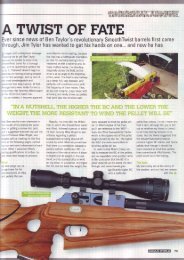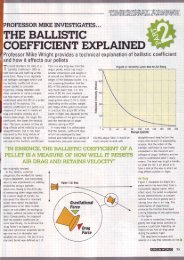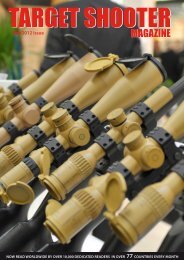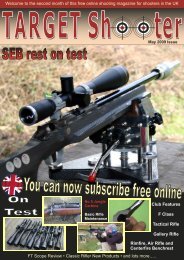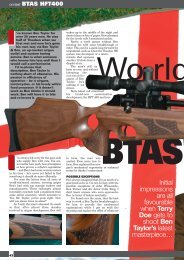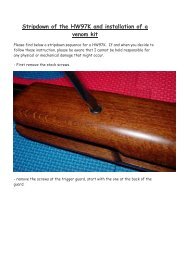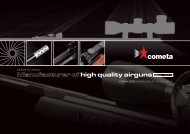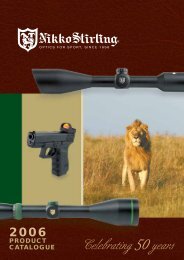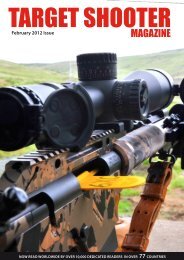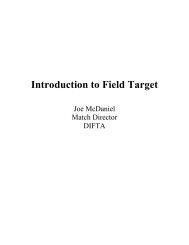Target Shooter 1
Target Shooter 1
Target Shooter 1
Create successful ePaper yourself
Turn your PDF publications into a flip-book with our unique Google optimized e-Paper software.
Three bullets compared. Left to right: 145gn<br />
standard RG 7.62mm from1980, note the<br />
crimping groove; 155gn 2004 RG 155gn ‘Bisley Match’;<br />
155gn Sierra Palma MatchKing (older model), a far superior<br />
product<br />
improved long-range performance.<br />
Actually, the .308W version<br />
appeared first in 1952, Winchester<br />
having been involved in T65<br />
development and recognising its<br />
commercial potential. The military<br />
had to wait for new weapons to<br />
arrive – Britain didn’t adopt<br />
the L1A1 ‘SLR’ rifle until 1957.<br />
Nevertheless, civilian shooters didn’t<br />
rush to the new cartridge even in<br />
the USA. American deerhunters<br />
were initially unconvinced this ‘little’<br />
cartridge could provide enough<br />
performance, and the country’s target shooters<br />
were critical of its ‘over-short’ neck, erroneously<br />
believing the .308 was less accurate than the tried<br />
and trusted ‘Oh-Six’ for some years. It soon<br />
became popular amongst British<br />
deerstalkers, but it took the end of 0.303” Mk7<br />
ammunition production at the Radway Green<br />
factory in the early 1960s for the NRA to start<br />
planning a replacement for Service Rifle,<br />
<strong>Target</strong> Rifle (TR) that started up during 1967/8<br />
and used military specification 7.62mm.<br />
7.62mm v .308W<br />
I’ve used ‘7.62’ and ‘308’ interchangeably,<br />
which to some extent the cartridges are,<br />
but they, and their rifles, are not identical.<br />
The former has a slightly lower specified<br />
peak chamber pressure, its chamber is a<br />
little bit roomier and longer with a greater<br />
acceptable headspace variation to ensure<br />
reliable operation with dirty or damaged<br />
ammo. There are differences in throat<br />
specifications, but the most significant<br />
variation is in bullet and barrel dimensions.<br />
The NATO bullet is 144-147gn (although<br />
the Americans preferred slightly heavier<br />
models), and usually a marginally smaller<br />
diameter than found in commercial 0.308”<br />
bullets – sometimes as low as 0.3072” while<br />
Bullet bases compared – left: 155gn RG; right:<br />
155gn Sierra. The RG FMJ has an open base and<br />
deep cavity – undesirable accuracy-wise as<br />
gasses overtaking the bullet at the muzzle can<br />
catch it and influence bullet behaviour randomly<br />
The 7.62mm rifle our NRA turned its<br />
collective nose up at, a short-barrelled<br />
version of the famous FN FAL adopted in<br />
modified form by Britain as the Rifle, L1A1<br />
<strong>Target</strong> <strong>Shooter</strong> 69



